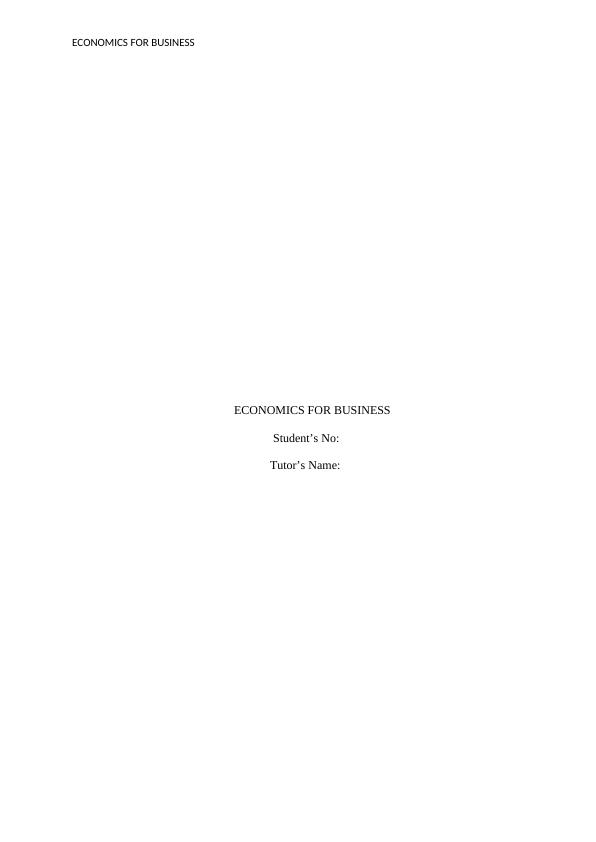Economics for Business (Solution)
15 Pages3840 Words97 Views
Added on 2020-01-28
Economics for Business (Solution)
Added on 2020-01-28
ShareRelated Documents
ECONOMICS FOR BUSINESSECONOMICS FOR BUSINESSStudent’s No:Tutor’s Name:

ECONOMICS FOR BUSINESSSupply side policies refer to the micro-economic policies whose aim is to make markets, industries or firms to operate in a more efficient manner and in the process spur faster underlying-rate of growth of real national output. In the public sphere, supply side policies are government policies whose aim is to increase the efficiency as well as the productivity of a nation’s economy (Torriti, et al. 2010, pp.1575-1583). A government’s supply side policies are considered successful if they are able to lower the natural rate of unemployment, enable a nation realize the productive capacities of its economy as well as able to improve the four factors of production in terms of the quality and quantity.It is the aim of every government across the world to facilitate the economic growth of the nation they govern. Faced by challenges such as unemployment, high inflation rates, low rates of economic growth as well as lack of equilibrium on the balance of payments on the citizens, every government seeks to implement policies to address these challenges (Besley&Persson, 2010, pp.1-34). Most governments across the world in their attempt to facilitate economic growth use supply side policies. The government employs the use of various measures to improve factor productivity.The government uses the tax system as a means of providing incentives to its population in itsattempt to stimulate factor output. This government initiative is always considered integral to supply side policy rather than initiatives to alter demand. Through this move, the government seeks to reduce direct tax rates; both income as well as corporation tax. Reducing the income tax acts as an incentive to a nation’s population especially the unemployed workers as they are encouraged to join the labour market (Lambin&Meyfroidt, 2011, pp.3465-3472). Reduction in the rate of income tax also encourages the employed members of the populationto work harder as they are able to realize the fruits of their labour. Similarly, reduction in the

ECONOMICS FOR BUSINESScorporation tax acts an incentive for entrepreneurs as they are encouraged to start businesses as well as expand on the existing businesses thereby increasing national output.In its attempt to promote productivity, the government also uses other supply-side policies such as promotion of greater competition in the labour markets. This policy is achieved by removing practice that restrict investment as well as by elimination of rigidities that might exist in the labour market such as employment protection. This supply-side policy was used in the United Kingdom in the 1980s as part of the supply-side reforms (Borras&Edguist, 2013, pp.1513-1522). During this period, the government of UK enacted measures that reduced the powers of trade unions such as limitation of the ability of workers to hold strikes as well as enforcement of secret ballots among union members before any strike to get their opinions and implement precautionary measures to avoid the strikes.Policies aimed at improving labour mobility also act as measures by the government to spur productivity. The government in its attempt to improve labour market flexibility encourages its labour force to move through the various employment levels. Employees are allowed and encouraged to move from one job to another as well as move from one level to another withinthe same job (Czernich, et al. pp.505-532). To enhance labour mobility, measures are put in place that encourage and support such mobility. For instance, the government encourages a promotion system based on merit. This encourages employees’ competition as well as boosts employees’ efficiency at the workplace.Most recent governments have put great emphasis on human capital development as a policy to promote productivity. This entails provision of better education as well as training to improve on the skills of the labour force, flexibility as well as improve labour mobility.

ECONOMICS FOR BUSINESSInvestment in the education and training of its population is an effective way of improving labour productivity of any government. This is an important supply-side policy option that has seen most nations across the world enhance their economic growth (Bonoli, 2010, pp.535-457). To improve the quality of education and ensure that its citizens acquire the necessary skills for economic growth, a government may set and monitor the standards of teaching and ensure that schools inculcate competent skills in their curriculum.A government may also adopt a performance-related pay system in the public sector as a means to enhance productivity. Through payment to the public sector based on their performance, the government is able to inject money into the economy, a move which will eventually cause a multiplier effect on the national income. Apart from spending through payments, the government also spends in public as a way to compensate for market failures. This may entail provision of public goods such as policing as well as infrastructure which promotes productivity. Similarly, the government provides welfare benefits as a means to ensuring a minimum standard of living (Calmfors, 2013, pp.319-353). For instance, the government of the United Kingdom provides its public sector with unemployment benefits such as Job Seeker’s Allowance, pensions, income guarantees as well as child allowances to parents for support in raising their children.Another means by which a government can improve productivity is by encouraging and supporting local pay bargaining as opposed to the central pay bargaining. This is because the national pay rates do not usually reflect the local conditions and hence cannot reduce labour mobility. Allowing local bargaining rates will enable a nation’s labour to move to areas where the labour is needed most.

End of preview
Want to access all the pages? Upload your documents or become a member.
Related Documents
Assignment: Economics for Businesslg...
|11
|2953
|276
Economics for Businesslg...
|15
|4123
|273
Economics for Business Assignment - (Doc)lg...
|14
|4493
|124
Economics Assignment (Question and Answer)lg...
|16
|3396
|57
Economics for Business : Assignmentlg...
|14
|3331
|335
Evaluating Sri Lankan economic performance & impact of supply side policieslg...
|20
|4424
|55
